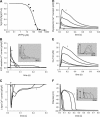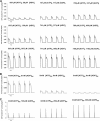Modeling regulation of cardiac KATP and L-type Ca2+ currents by ATP, ADP, and Mg2+
- PMID: 15738467
- PMCID: PMC1305273
- DOI: 10.1529/biophysj.104.046284
Modeling regulation of cardiac KATP and L-type Ca2+ currents by ATP, ADP, and Mg2+
Abstract
Changes in cytosolic free Mg(2+) and adenosine nucleotide phosphates affect cardiac excitability and contractility. To investigate how modulation by Mg(2+), ATP, and ADP of K(ATP) and L-type Ca(2+) channels influences excitation-contraction coupling, we incorporated equations for intracellular ATP and MgADP regulation of the K(ATP) current and MgATP regulation of the L-type Ca(2+) current in an ionic-metabolic model of the canine ventricular myocyte. The new model: 1), quantitatively reproduces a dose-response relationship for the effects of changes in ATP on K(ATP) current, 2), simulates effects of ADP in modulating ATP sensitivity of K(ATP) channel, 3), predicts activation of Ca(2+) current during rapid increase in MgATP, and 4), demonstrates that decreased ATP/ADP ratio with normal total Mg(2+) or increased free Mg(2+) with normal ATP and ADP activate K(ATP) current, shorten action potential, and alter ionic currents and intracellular Ca(2+) signals. The model predictions are in agreement with experimental data measured under normal and a variety of pathological conditions.
Figures







References
-
- Aguilar-Bryan, L., C. G. Nichols, S. W. Wechsler, J. P. Clement, A. E. Boyd, G. Gonzales, H. Herrera-Sosa, K. Nguy, J. Bryan, and D. A. Nelson. 1995. Cloning of the beta cell high-affinity sulfonylurea receptor: a regulation of insulin secretion. Science. 268:423–426. - PubMed
-
- Agus, Z. A., E. Kelepouris, I. Dukes, and M. Morad. 1989. Cytosolic magnesium modulates calcium channel activity in mammalian ventricular cells. Am. J. Physiol. 256:C425–C455. - PubMed
-
- Albitz, R., H. Kammermeier, and B. Nilius. 1990. Free energy of ATP-hydrolysis fails to affect ATP-dependent potassium channels in isolated mouse ventricular cells. J. Mol. Cell. Cardiol. 22:183–190. - PubMed
-
- Alekseev, A. E., M. E. Kennedy, B. Navarro, and A. Terzic. 1997. Burst kinetics of co-expressed Kir6.2/SUR1 clones: comparison of recombinant with native ATP-sensitive K+ channel behavior. J. Membr. Biol. 159:161–168. - PubMed
-
- Ashcroft, F. M., and S. J. Ashcroft. 1990. Properties and functions of ATP-sensitive K-channels. Cell. Signal. 2:197–214. - PubMed
Publication types
MeSH terms
Substances
Grants and funding
LinkOut - more resources
Full Text Sources
Miscellaneous

